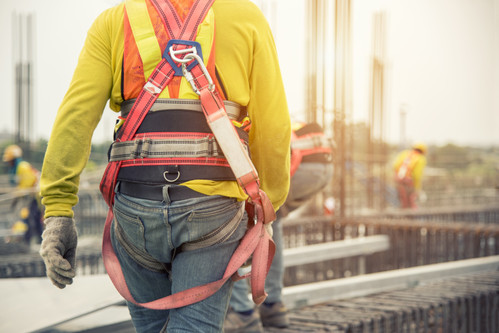Suspension Trauma and Why Minutes Matter
Properly used, fall protection equipment will prevent your workers from impacting the ground, but you still have to find a way to get them down from height. Every minute matters when it comes to rescuing one of your employees after a fall. According to Occupational Safety and Health Administration (OSHA), "suspension in a fall arrest device can result in unconsciousness, followed by death, in less than 30 minutes." Read on find out how you can best prepare for a fall.
The Dangers of Hanging around Too Long
Full body harnesses are required in virtually all fall prevention scenarios. And while they do an admirable job of arresting a fall with minimal impact force on the body, they do have one point to keep in mind. The leg straps that help distribute the impact, will also restrict circulation in the legs. Even though a safety lanyard provided a nice soft stop, a worker may start to lose feeling in their limbs after hanging in the air for a short time. Left unattended, this will progress quickly to an ugly end. You will need to come up with a rescue plan in the event of a fall, so you can get these workers back on their feet as soon as possible.
Use these tips to reduce suspension trauma and form a rescue plan that works for you and your team.
Create a Rescue Plan
If someone falls on the job, know that it may take first responders several minutes to arrive on the scene. These professionals might not be qualified to rescue workers in the air or be familiar with the equipment you’re using. Having the local rescue squad or fire department as 'Plan A' is frowned upon.
Rescue plans don’t have to be complicated. In some situations even a portable ladder can do the job. Simple plans do work, but they need to be noted and practiced before an accident happens for them to be completed swiftly when an emergency arises. This plan should include details about when and how your team can retrieve the suspended worker. Should an accident happen, your team will be prepared with an action plan that can save time during those critical minutes.
Tips for Reducing Suspension Trauma
When creating this rescue plan, designate who will be performing the rescue and how. Consider where the rescue will take place based on the suspended worker’s location. Create a map of all possible fall hazards around your workplace and how you plan on responding to each type of incident. Look for additional on-the-job hazards and designate safe places where a rescue may be able to take place. You should also keep emergency medical supplies on hand in case the worker needs urgent medical assistance.
You can use a range of fall protection equipment to speed up the rescue process. Self-retracting lines (SRLs) will reduce the distance if they suffer from a fall. The spring loaded lifeline automatically retracts, thus limiting the length of the fall. The SRL keeps the worker near where the fall took place, so they don’t accidentally swing into other equipment or nearby structures. Horizontal life lines may induce a swing-fall, pushing workers to the left or right, further complicating your rescue plans.
Suspension trauma straps will help keep the worker more comfortable in the air. These handy devices are inexpensive and lightweight. Usually made of nylon or polyester, they attach to the harness, ready to be deployed by the fallen worker. They simply extend the strap, which is attached to the sides of the harness, and insert their feet. This allows a standing position, which greatly reduces the pressure on the legs.
One further note for that rescue plan; what if the worker is unconscious and cannot engage the straps?
You can also use a fall rescue kit to gently lower the employee to safety. The pulley system moves the worker to a safe location.
Contact the team at PK Safety to choose the right vertical safety system for your business.
SHOP RESCUE & DESCENT SYSTEMS EQUIPMENT
Recent Posts
-
Customizing Gas Detectors: Tailoring Solutions to Fit Your Unique Requirements
In today’s diverse industrial landscape, a one-size-fits-all approach to safety simply doesn’t cu …Jul 3rd 2024 -
10 Ways to Prevent Wildfires
You can prevent wildfires by extinguishing flames before you leave the worksite. Avoid practicing …Jul 1st 2024 -
ANSI/ISEA 138 Safety Gloves: Ensuring Hand Protection
The human hand is an anatomical masterpiece and arguably the greatest tool attached to our bodies …Jun 25th 2024





